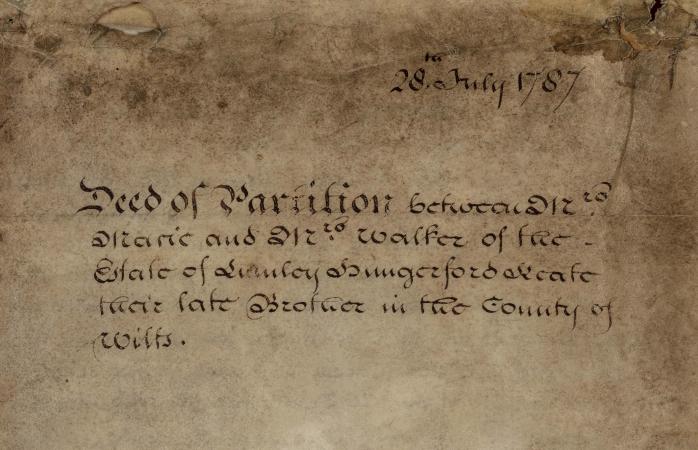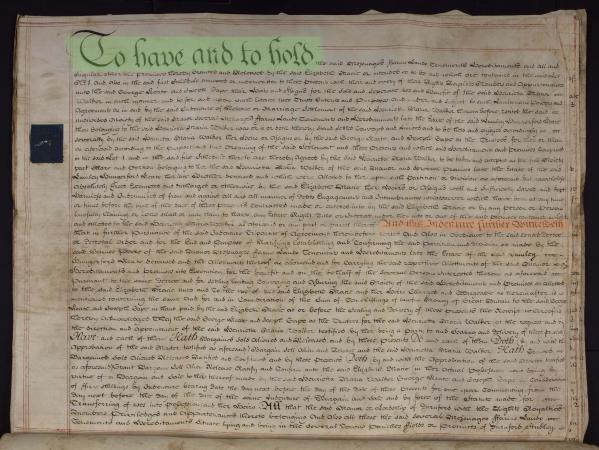When we began teleworking in March, I decided that, if I couldn’t work in our conservation lab on normal treatments, I would devote some time and effort to the Hungerford Deed, one of the Archives’ most prized collection items. It’s a key link in our understanding of where James Smithson obtained the wealth that he eventually bequeathed to the United States to form the Smithsonian. (Check out my blog post from last year here, where you can read about the initial treatment and preliminary research we’ve done.) Specifically, I hoped to research and plan a treatment strategy. I began looking into similar examples at other institutions, best practices for parchment conservation, preservation of wax seals, and different materials I would need for my proposed treatment (once we return to work, look for an eventual update on the deed’s treatment on the blog). From there, I moved on to more research into the deed itself, looking to better understand its context and contents.

One of the areas I became most interested in is the legal structure of the deed and how it compares to other legal documents of the period. In my research, I came across a fantastic guide on the University of Nottingham’s website, which gave both an excellent overview of British property deeds from the Middle Ages to the present day, as well as a more in-depth look at the different types of deeds and a helpful flowchart for categorizing them. Reading through these webpages greatly enhanced my understanding of the Hungerford Deed, and I’ll summarize some of my most interesting finds here.
What kind of a deed is it?
The Hungerford Deed is described on its reverse as a deed of partition—a division of properties between co-owners. In this case, the division is between James Smithson’s mother, Elizabeth Macie, and her sister, Henrietta Maria Walker, as co-heirs to their late brother’s estate (for a general summary of the deed’s contents, see my previous post, linked again here). Based on my research and reading of the deed, the document appears to function both as a deed of conveyance (meaning a transfer or establishment of ownership) and a deed of covenant. The deed of covenant is a legal tool used in cases like this one, where a larger estate is being broken into smaller properties, and it becomes important to be able to verify legal ownership by paperwork. In a deed of covenant, the parties agree (or “covenant”) to produce the needed documents when a question of ownership is raised. The phrase “covenant promise and agree,” as well as the schedules or lists of properties appended to the deed, are strong clues to this identification.

How is the deed structured?
Like most legal documents, deeds like ours are formulaic, and this helps us break down the dense language into understandable chunks. First come dates (both the regnal year—establishing the time in reference to the current monarch, George III in this case—and the calendar year) and a list of the various parties to the deed. Next come the recitals, a summary of the history of the transaction being executed; these are signaled by the phrase “[and] whereas,” and in the Hungerford Deed, they provide a compelling portrait of the family’s complicated relationship. After that, the testatum or operative parts describe the purpose of the deed, the property transaction in question, and is marked by the phrase “[this indenture] witnesseth”; then comes a description of the properties in question; next the habendum or terms of the estate (how long the agreement is in force), in this case, “for ever”; this is followed by any further conditions or provisos; and lastly, the parties witness the document as legally binding. In addition, the Hungerford Deed has two independent witnesses (one of whom is James Smithson, under his birth name, James Macie) recorded on the reverse of the deed. There is still a lot to parse in the testatum, including some archaic legal terms given in Norman French, but that is fodder for another post!

As you can see, there is an amazing amount of content for us to unpack in the Hungerford Deed, and this is only one aspect of its history and purpose. I’ll leave you with one final thought. In aligning the key dates of the deed with those of James Smithson’s life, I found it compelling that the dramatic family story it tells begins only a year after Smithson’s birth and concludes shortly after his acceptance into the Royal Society—a sure sign of his having “made it” in the circles he frequented. It’s fitting, too, that this deed, executed in the Chancery Court and which represents the seeds of Smithson’s fortune, would be the spiritual progenitor of Smithson’s will, the terms of which Richard Rush successfully pushed through the same court fifty-one years later. Thanks to both of these documents, we now have the nineteen museums and research centers that make up the Smithsonian.
Related Resources
- "A Tale of Three Contracts," by William Bennett, The Bigger Picture, Smithsonian Institution Archives
- "Hungerford Family Visits the Smithsonian," by Pam Henson, The Bigger Picture, Smithsonian Institution Archives
Produced by the Smithsonian Institution Archives. For copyright questions, please see the Terms of Use.

Leave a Comment